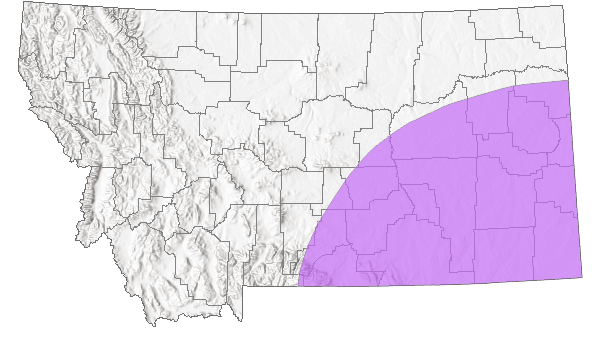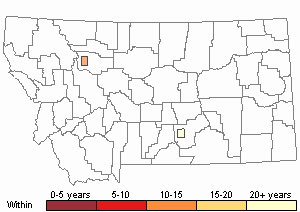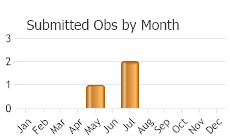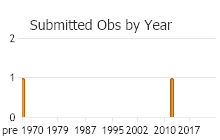View in other NatureServe Network Field Guides
NatureServe
Montana
Utah
Wyoming
Idaho
Wisconsin
British Columbia
South Carolina
Yukon
California
New York
Wrinkled Grasshopper - Hippiscus ocelote
General Description
The following is taken from Hebard (1928), Helfer (1971), Otte (1984), Capinera and Sechrist (1982), Vickery and Kevan (1985), McDaniel (1987), Capinera et al. (2004), Kirk and Bomar (2005), Brust et al. (2008), and Scott (2010). Some of the early literature lists this species as Hippiscus rugossus. The species’ name was changed to H. ocelote in the 1980’s. This is a large, heavy bodied grasshopper. The body color is brown or grayish brown. The forewings (tegmina) have large dark spots and a light band which, when folded and viewed dorsally, converge into a V-shape. The hind wing basal disk can be pale yellow, pinkish, or orangish, bearing a dark narrow, central crossband with the spur extending about two-thirds distance toward the wing base, the tip is transparent. The pronotum (thorax) is rough and wrinkled (hence its name), and often has a light X-shaped mark dorsally, especially in males. The outer face of the hind femur bear two to three oblique dark crossbands. The inner face is pale to yellow with three black bands and knee. The hind tibia is yellow with a pale area at the base.
Communicative behavior/Crepitation*
This species is not known to crepitate nor perform flight displays. Aggressive displays among males includes femur tipping and shaking (Otte 1970, Vickery and Kevan 1985).
Phenology
This species overwinters in the egg stage. Nymphs occur in mid-June and are present to late August. Adults can be found from July to November, and most common from September to November. This is one of the last grasshoppers to disappear in autumn (Capinera and Sechrist 1982, and Scott 2010).
Diagnostic Characteristics
The following comes from Hebard (1928), Helfer (1971), Capinera and Sechrist (1982), Otte (1984), Vickery and Kevan (1985), McDaniel (1987), Capinera et al. (2004), Kirk and Bonner (2005), Brust et al. (2008), and Scott (2010). The body length to the end of the forewings is 28-40 mm for males, and females 39-54 mm.
The Wrinkled Grasshopper can be easily confused with the
Red-shanked Grasshopper (
Xanthippus corallipes) (refer to that species for diagnostic comparisons) (Capinera et al. 2004, and Scott 2010).
Species Range
Montana Range
Range Descriptions

 Native
Native
Range Comments
The Wrinkled Grasshopper occurs across the eastern two-thirds of the U.S. as far west as southwest Montana, eastern Wyoming, and Colorado, and southward into Mexico. It is absent in Canada, New England, and the Great Lake states. In Montana, it has been reported for 7 counties in the southeast corner of the state (Otte 1970, Vickery and Kevan 1985, Capinera et al. 2004, and Scott 2010).
Observations in Montana Natural Heritage Program Database
Number of Observations: 3
(Click on the following maps and charts to see full sized version)
Map Help and Descriptions
Relative Density

Recency


 (Observations spanning multiple months or years are excluded from time charts)
(Observations spanning multiple months or years are excluded from time charts)
Habitat
This species inhabits prairies, pastures, open woodlands, along roadsides, alfalfa fields, almost any grassy area within its geographic range (Otte 1970, Vickery and Kevan 1985, and Capinera et al. 2004).
Food Habits
The Wrinkled Grasshopper feeds almost entirely on grasses consisting of wheatgrass,
Little Bluestem (
Schizachyrium scoparium),
Side-oats Grama (
Bouteloua curtipendula),
Blue Gramma (
Bouteloua gracilis) (especially consumed by nymphs), bluegrass,
needle-and-thread (
Stipa comata),
Thread-leaved Sedge (
Carex filifolia),
Japanese Brome (
Bromus japonicus), and
Lead Plant (
Amorpha canescens) (Capinera and Sechrist 1982, Vickery and Kevan 1985, and Brust et al. 2008).
Reproductive Characteristics
During courtship, an approaching male may or may not stridulate before attempting to mount. When they do mount, the male rapidly taps the female’s head and sometimes makes pronounced lateral head-rocking movements. Little else has been reported in the literature regarding the reproductive cycle of this species (Otte 1970, 1984).
Stewardship Responsibility
References
- Literature Cited AboveLegend:
 View Online Publication
View Online Publication Brust, M.L, W.W. Hoback, and R.J. Wright. 2008. The Grasshoppers of Nebraska. Lincoln, NB: University of Nebraska Extension Service, APHIS.
Brust, M.L, W.W. Hoback, and R.J. Wright. 2008. The Grasshoppers of Nebraska. Lincoln, NB: University of Nebraska Extension Service, APHIS. Capinera, J.L. and T.S. Sechrist. 1982. Grasshoppers of Colorado: Identification, Biology, and Management. Fort Collins, CO: Colorado State University Experiment Station, Bulletin 584S. 161 p.
Capinera, J.L. and T.S. Sechrist. 1982. Grasshoppers of Colorado: Identification, Biology, and Management. Fort Collins, CO: Colorado State University Experiment Station, Bulletin 584S. 161 p. Capinera, J.L., R.D. Scott, and T.J. Walker. 2004. Field Guide to Grasshoppers, Katydids, and Crickets of the United States. Ithaca, NY. Cornell University Press.
Capinera, J.L., R.D. Scott, and T.J. Walker. 2004. Field Guide to Grasshoppers, Katydids, and Crickets of the United States. Ithaca, NY. Cornell University Press. Hebard, M. 1928. The Orthoptera of Montana. Proceedings of the Academy of Natural Sciences of Philadelphia, Vol. 80:211-306.
Hebard, M. 1928. The Orthoptera of Montana. Proceedings of the Academy of Natural Sciences of Philadelphia, Vol. 80:211-306. Helfer, J.R. 1971. How to Know the Grasshoppers, Crickets, Cockroaches, and Their Allies. Revised edition (out of print), Mineola, NY: Dover Publications.
Helfer, J.R. 1971. How to Know the Grasshoppers, Crickets, Cockroaches, and Their Allies. Revised edition (out of print), Mineola, NY: Dover Publications. Kirk, K. and C.R. Bomar. 2005. Guide to the grasshoppers of Wisconsin. Madison, WI: Wisconsin Department of Natural Resources, Bureau of Integrated Science Services PUB-SS-1008. 154 p.
Kirk, K. and C.R. Bomar. 2005. Guide to the grasshoppers of Wisconsin. Madison, WI: Wisconsin Department of Natural Resources, Bureau of Integrated Science Services PUB-SS-1008. 154 p. McDaniel, B. 1987. Grasshoppers of South Dakota. Brookings, SD: South Dakota Agricultural Experiment Station, Bulletin TB 89.
McDaniel, B. 1987. Grasshoppers of South Dakota. Brookings, SD: South Dakota Agricultural Experiment Station, Bulletin TB 89. Otte, Daniel. 1970. A comparative study of communicative behavior in grasshoppers. Miscellaneous Publications, Museum of Zoology, No. 141. Ann Arbor, MI: University of Michigan.
Otte, Daniel. 1970. A comparative study of communicative behavior in grasshoppers. Miscellaneous Publications, Museum of Zoology, No. 141. Ann Arbor, MI: University of Michigan. Otte, Daniel. 1984. The North American Grasshoppers Volume II. Acrididae (Oedipodinae). Harvard University Press. 366 pp.
Otte, Daniel. 1984. The North American Grasshoppers Volume II. Acrididae (Oedipodinae). Harvard University Press. 366 pp. Scott, R.D. 2010. Montana Grasshoppers, Katydids, and Crickets A Pictorial Field Guide to the Orthoptera. MagpieMTGraphics, Billings, MT.
Scott, R.D. 2010. Montana Grasshoppers, Katydids, and Crickets A Pictorial Field Guide to the Orthoptera. MagpieMTGraphics, Billings, MT. Vickery, V. R. and D. K. M. Kevan. 1985. The grasshopper, crickets, and related insects of Canada and adjacent regions. Biosystematics Research Institute, Ottawa, Ontario. Publication Number 1777. 918 pp.
Vickery, V. R. and D. K. M. Kevan. 1985. The grasshopper, crickets, and related insects of Canada and adjacent regions. Biosystematics Research Institute, Ottawa, Ontario. Publication Number 1777. 918 pp.
- Additional ReferencesLegend:
 View Online Publication
View Online Publication
Do you know of a citation we're missing? Anderson, N.L. 1951. Field studies on the biology of range grasshoppers of southeastern Montana. M.Sc. Thesis. Bozeman, Montana: Montana State University. 96 p.
Anderson, N.L. 1951. Field studies on the biology of range grasshoppers of southeastern Montana. M.Sc. Thesis. Bozeman, Montana: Montana State University. 96 p. Anderson, N.L. 1962. Grasshopper-vegetation relationships on Montana grasslands. Ph.D Dissertation. Bozeman, Montana: Montana State University. 73 p.
Anderson, N.L. 1962. Grasshopper-vegetation relationships on Montana grasslands. Ph.D Dissertation. Bozeman, Montana: Montana State University. 73 p. Brooks, A.R. 1958. Acridoidea of Southern Alberta, Saskatchewan, and Manitoba (Orthoptera). The Canadian Entomologist (Supplement 9) 90:5-92.
Brooks, A.R. 1958. Acridoidea of Southern Alberta, Saskatchewan, and Manitoba (Orthoptera). The Canadian Entomologist (Supplement 9) 90:5-92.
- Web Search Engines for Articles on "Wrinkled Grasshopper"
- Additional Sources of Information Related to "Insects"





